
The Browning BAR is drilled and tapped for scope bases. I picked up a Warne one piece base that was catalog illustrated with continuous Weaver/Picatinny slots, but it actually has only a couple of slots that don’t offer much latitude in ring placement. A simple two piece Millet base set and Millet Angle-Loc rings made for a much better mechanical and aesthetic fit.
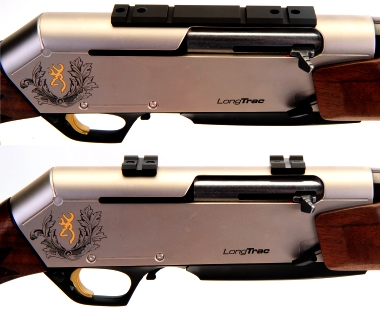
As an additional benefit, angle lock rings have an integral windage adjustment, which allows a scope to be mechanically adjusted so that optical adjustment is neutral. The rings appear lightly constructed in comparison to some other rings sets, but they stayed put even under the effects of frequent and heavy recoil.
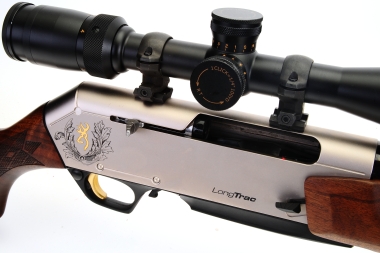
With scope mounted, factory ammo was shot to baseline the rifle’s overall performance and accuracy. Shooting the Browning BAR is a bit like driving a high performance BMW or Audi sedan; you focus on driving and the road ahead and the car’s systems take care of the incidentals. There is no break in concentration or hold while turning a bolt handle, or flipping a lever.
Familiarization and proficiency building… Sounds like a seminar
It is easy to become a proficient BAR shooter. Below are the first nine factory rounds I put through the LongTrac. Three shot groups progressed from 1 1/4″ to approximately 1″ and concluded with a 1/2″ group.

Any 300 Winchester Magnum will keep you from dozing at the bench and the Browning is no exception. The LongTrac has a good feel… light, but balanced, magnum recoil, but recoil dampened enough to be manageable. There was no significant loss in performance caused by the gas system. Remington 150 grain Core-Lokt PSP ammo, rated at 3,290 fps MV from a 24″ test barrel, clocked 3,236 fps over the Oehler Proof Screen Chronograph with the LongTrac’s 24″ barrel. That difference is minor enough to be the result of measurement methods and sky screen placement.
Brass, our malleable friend…
Whenever possible, once fired brass is used from the subject rifle for handloads. This provides an opportunity to inspect fired brass and to make some assessment of the firearm’s mechanical functions, it permits optimal set up of dies and helps with load planning for the individual rifle.

| Baseline | A” | B” | C” | D” | E” | F” | ||||||
| SAAMI Max Chamber | 2.644 | 2.289 | 3.344 | .0.492 | 0.515 | 0.547 | ||||||
| SAAMI Max Cartridge | 2.620 | 2.270 | 3.341 | 0.491 | 0.514 | 0.532 | ||||||
| Unfired Brass* | 2.609 | 2.271 | 0.334 | 0.486 | 0.505 | 0.528 | ||||||
| Sample | ||||||||||||
| Fired | Sized | Fired | Sized | Fired | Sized | Fired | Sized | Fired | Sized | Fired | Sized | |
| 1 | 2.616 | 2.620 | 2.276 | 2.277 | 0.342 | 0.334 | 0.492 | 0.489 | 0.512 | 0.512 | 0.530 | 0.530 |
| 2 | 2.604 | 2.612 | 2.280 | 2.277 | 0.341 | 0.335 | 0.492 | 0.487 | 0.513 | 0.512 | 0.532 | 0.532 |
| 3 | 2.619 | 2.624 | 2.278 | 2.277 | 0.342 | 0.335 | 0.492 | 0.489 | 0.513 | 0.512 | 0.532 | 0.532 |
| 4 | 2.617 | 2.624 | 2.277 | 2.277 | 0.342 | 0.335 | 0.491 | 0.489 | 0.512 | 0.512 | 0.531 | 0.531 |
| 5 | 2.615 | 2.620 | 2.278 | 2.277 | 0.342 | 0.335 | 0.492 | 0.488 | 0.513 | 0.512 | 0.532 | 0.532 |
| 6 | 2.613 | 2.618 | 2.279 | 2.277 | 0.342 | 0.334 | 0.492 | 0.489 | 0.513 | 0.512 | 0.532 | 0.532 |
| 7 | 2.610 | 2.615 | 2.280 | 2.277 | 0.341 | 0.335 | 0.490 | 0.489 | 0.512 | 0.512 | 0.530 | 0.530 |
| 8 | 2.609 | 2.614 | 2.277 | 2.277 | 0.341 | 0.335 | 0.492 | 0.488 | 0.513 | 0.512 | 0.530 | 0.530 |
| 9 | 2.619 | 2.626 | 2.277 | 2.278 | 0.341 | 0.335 | 0.492 | 0.488 | 0.513 | 0.512 | 0.530 | 0.530 |
| 10 | 2.604 | 2.620 | 2.278 | 2.277 | 0.340 | 0.335 | 0.490 | 0.489 | 0.513 | 0.512 | 0.532 | 0.532 |
| *Average of ten factory rounds +/- < .0005″ variance for any measurement | ||||||||||||
The 300 Winchester Magnum’s chamber headspace dimension is measured from breech face to leading edge of the belt recess, 0.220″ – 0.227″. There is a corresponding cartridge case referencedimension of 0.207″ -0.008″. Additionally, there is a chamber reference dimension from breech face to a point on the shoulder that is 0.420″ in diameter, 2.279″ +0.010″ and there is a corresponding cartridge reference point 2.270″ -0.007″ (“B” in the table).
dimension from breech face to a point on the shoulder that is 0.420″ in diameter, 2.279″ +0.010″ and there is a corresponding cartridge reference point 2.270″ -0.007″ (“B” in the table).
Fired brass from the Browning measured 2.276″ min / 2.280″ max at dimension “B”, an increase of 0.005″ to 0.009″ over the unfired brass, which is typical for almost any high power centerfire rifle. Resized, that reference dimension became uniformly 2.277″. Both fired and resized dimensions were comfortably under the maximum chamber specification and none exceeding the cartridge maximum specification. As a functional check, sized brass was manually cycled through the Browning.
Case capacity was checked using grains of water as the standard for measurement. Unfired brass wet checked at 89.2 grains, brass fired in the Browning BAR 92.8 grains and resized brass 93.1 grains. Net case capacity is one of those areas that gets people in trouble when they use published maximum loads as a starting point. Theoretically, a specific 150 grain bullet may work with a charge of 74.5 grains of H4350 that yields maximum, but safe pressure in concert with a 93.1 grain capacity case. If the same load is applied to the 89.2 grain case, the result would be a pressure increase of over 7,000 PSI and an unsafe pressure level. A reduction of over two grains would be required to attain safe pressure levels with the smaller case, however, using that reduced charge in the larger 93.1 case would reduce pressure by approximately 8,000 PSI below maximum, and 100 fps of muzzle velocity would be surrendered. It all matters.
 The Browning LongTrac did not do any real damage to brass, but it did boot it out of the ejection port with a certain degree of… confidence.
The Browning LongTrac did not do any real damage to brass, but it did boot it out of the ejection port with a certain degree of… confidence.
There was the occasional case mouth ding or ejector stamp of approval on a random caseheads, but a full length sizer die ironed out the dings and the ejector marks were superficial and, therefore, of no consequence.
The fired brass was run through a standard full length sizer die, tumbled, washed and trimmed, off press primed, charged and bullets were press seated. No special prep, no special dies with the exception of a Lee Precision Factory Crimp Die that was utilized whenever a bullet cannelure was present. Next time I load for this cartridge I will lathe turn a slightly undersize expander to get increased neck tension where a crimp is not applied. Bullets like the North Fork Bonded and, to some degree the Barnes driving band bullets, give up a lot of friction surface area for the sake of reducing copper fouling and they can benefit from a bit more case neck tension.
Negen specifieke kogels or Neuf balles spécifiques
Nine out of a possible 7,468,962 bullet types available for thirty caliber cartridges were selected. More specifically, thirty caliber bullets that could be pushed to magnum velocity levels and perform as intended were selected, bullets of differing construction, hopefully to suit everyone’s interest.
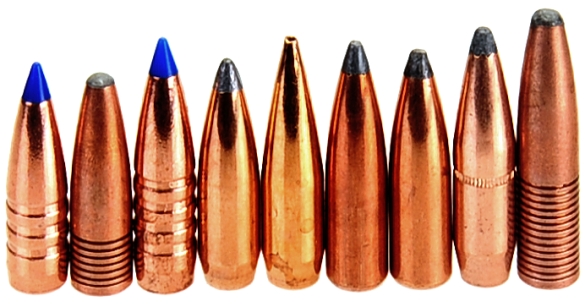
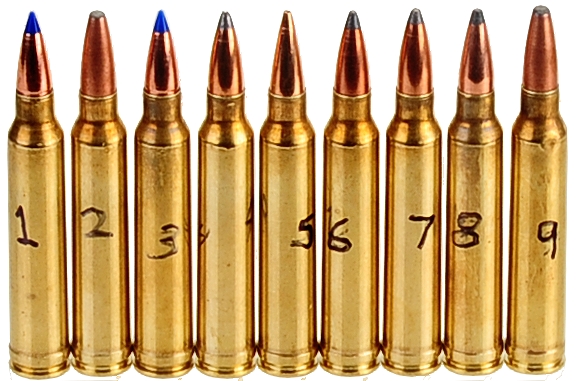
Relative to case size, the 300 Winchester Magnum has a short neck and a short COL, consequently, bullets like the Berger and longish Nosler Partition get seated with the case mouth right at the onset of the bullet’s ogive. A Lee Factory Crimp Die was used for all of the handloads, even where bullets did not have a cannelure to receive the crimp.
Eventually, things looked a lot like this…
Warning: Bullet selections are specific, and loads are not valid with substitutions of different bullets of the same weight. Variations in bullet length will alter net case capacity, pressure and velocity. Primer selection is specific and primer types are not interchangeable. These are maximum loads in my firearms and may easily be excessive in others. All loads should be reduced by 5%, and developed following safe handloading practices as represented in established reloading manuals produced by component manufacturers. Presentation of these loads does not constitute a solicitation for their use, nor a recommendation.
|
Cartridge: 300 Winchester Magnum |
|
| |
|
| |
|
| |
|
| |
|
| Bullet | Bullet Weight Grains |
Net Water Capacity H2O |
COL” | Powder Type | Powder Charge Grains |
Muzzle Velocity FPS |
Muzzle Energy Ft-Lbs |
100 Yard Group Size 3 Shot “ |
|
| Barnes TTSX | 130 | 84.8 | 3.340 | RL19 | 81.0 | 3459 | 3455 | 1.0 | |
| Barnes TTSX | 130 | 84.8 | 3.340 | H4350 | 77.0 | 3414 | 3365 | 1.2 | |
| Barnes TTSX | 130 | 84.8 | 3.340 | IMR7828SSC | 84.0 | 3469 | 3475 | 0.5 | |
| North Fork Bonded | 150 | 85.9 | 3.340 | RL19 | 80.0 | 3322 | 3675 | 1.1 | |
| North Fork Bonded | 150 | 85.9 | 3.340 | H4831 SC | 81.5 | 3278 | 3579 | 0.9 | |
| North Fork Bonded | 150 | 85.9 | 3.340 | IMR7828SSC | 83.5 | 3408 | 3869 | 1.2 | |
| Barnes TTSX | 150 | 82.5 | 3.340 | MagPro | 84.0 | 3323 | 3678 | 1.1 | |
| Barnes TTSX | 150 | 82.5 | 3.340 | RL19 | 77.0 | 3298 | 3623 | 0.8 | |
| Barnes TTSX | 150 | 82.5 | 3.340 | IMR7828SSC | 80.0 | 3299 | 3626 | 0.9 | |
| Sierra SPBT | 165 | 85.2 | 3.340 | RL22 | 81.0 | 3195 | 3740 | 0.9 | |
| Sierra SPBT | 165 | 85.2 | 3.340 | H4831SC | 79.5 | 3127 | 3583 | 0.9 | |
| Sierra SPBT | 165 | 85.2 | 3.340 | IMR7828SSC | 81.5 | 3296 | 3981 | 0.6 | |
| Berger VLD Hunting | 175 | 82.9 | 3.340 | MagPro | 82.5 | 3136 | 3821 | 0.9 | |
| Berger VLD Hunting | 175 | 82.9 | 3.340 | RL22 | 78.5 | 3125 | 3796 | 0.8 | |
| Berger VLD Hunting | 175 | 82.9 | 3.340 | IMR7828SSC | 79.0 | 3145 | 3844 | 1.0 | |
| Nosler Partition | 180 | 82.8 | 3.340 | MagPro | 82.0 | 3103 | 3849 | 1.2 | |
| Nosler Partition | 180 | 82.8 | 3.340 | RL22 | 78.0 | 3067 | 3656 | 1.2 | |
| Nosler Partition | 180 | 82.8 | 3.340 | IMR7828SSC | 78.0 | 3096 | 3832 | 0.9 | |
| Sierra SP | 180 | 84.1 | 3.340 | RL22 | 79.0 | 3104 | 3850 | 1.0 | |
| Sierra SP | 180 | 84.1 | 3.340 | IMR7828SSC | 78.5 | 3100 | 3842 | 1.0 | |
| Sierra SP | 180 | 84.1 | 3.340 | RS Magnum | 85.0 | 3142 | 3945 | 1.1 | |
| Hornady BTSP | 190 | 82.4 | 3.340 | MagPro | 80.5 | 3038 | 3893 | 0.8 | |
| Hornady BTSP | 190 | 82.4 | 3.340 | RL22 | 76.5 | 3019 | 3845 | 1.2 | |
| Hornady BTSP | 190 | 82.4 | 3.340 | IMR7828SSC | 77.0 | 3004 | 3808 | 0.9 | |
| North Fork Bonded | 200 | 80.1 | 3.340 | MagPro | 78.0 | 2958 | 3886 | 1.2 | |
| North Fork Bonded | 200 | 80.1 | 3.340 | RL22 | 74.5 | 2972 | 3922 | 1.1 | |
| North Fork Bonded | 200 | 80.1 | 3.340 | IMR7828 | 74.0 | 2933 | 3821 | 1.0 |
Which means exterior ballistics look like this…
| Indices | Barnes 130 Grain | ||||||||||
| Range -yds | 0 | 50 | 100 | 150 | 200 | 250 | 300 | 350 | 400 | 450 | 500 |
| Velocity – ft./sec. | 3500 | 3346 | 3198 | 3055 | 2917 | 2783 | 2652 | 2526 | 2403 | 2283 | 2168 |
| Energy – ft.-lbs. | 3535 | 3231 | 2951 | 2694 | 2456 | 2235 | 2031 | 1841 | 1666 | 1505 | 1356 |
| Path – in. | -1.5 | 0.8 | 2.3 | 3.0 | 2.7 | 1.4 | -1.0 | -4.7 | -9.7 | -16.2 | -24.4 |
| Berger 175 | |||||||||||
| Range -yds | 0 | 50 | 100 | 150 | 200 | 250 | 300 | 350 | 400 | 450 | 500 |
| Velocity – ft./sec. | 3150 | 3058 | 2967 | 2878 | 2791 | 2705 | 2621 | 2538 | 2457 | 2378 | 2300 |
| Energy – ft.-lbs. | 3855 | 3632 | 3420 | 3218 | 3026 | 2843 | 2668 | 2503 | 2346 | 2197 | 2055 |
| Path – in. | -1.5 | 0.9 | 2.5 | 3.0 | 2.5 | 0.8 | -2.0 | -6.1 | -11.5 | -18.4 | -26.8 |
| Hornady 190 Grain | |||||||||||
| Range -yds | 0 | 50 | 100 | 150 | 200 | 250 | 300 | 350 | 400 | 450 | 500 |
| Velocity – ft./sec. | 3050 | 2953 | 2858 | 2765 | 2674 | 2584 | 2496 | 2410 | 2326 | 2244 | 2164 |
| Energy – ft.-lbs. | 3924 | 3679 | 3446 | 3225 | 3015 | 2816 | 2629 | 2451 | 2283 | 2124 | 1974 |
| Path – in. | -1.5 | 1.0 | 2.5 | 3.0 | 2.3 | 0.4 | -2.8 | -7.4 | -13.5 | -21.2 | -30.6 |
I know very accomplished hunters who hunt antelope with handloads based on the 308 caliber, 130 Grain Barnes TTSX. Personally, I’ve not seen an exterior ballistic chart that would make me want to load anything lighter than 165 grains for the 300 Winchester Magnum, something in the 165 grain to 220 grain range, and they would be short bullets – all lead core… probably bonded single core. Solid copper and solid copper shank bullets, both which are highly popular and used routinely for hunting, reduce cartridge case capacity and they are often over penetrating. Additionally, they have inferior sectional density and the resulting long heavy bullet length taxes rifling twist rates. Solid copper bullets are the product of politicians and environmental extremists and ammunition and component companies trying to dig themselves out of a rough situation with hyperactive marketing efforts.
And back around to the star of the show…
The Browning LongTrac had no problem digesting anything it was fed. You may have noticed that the COL for all loads was 3.340″. There was no bullet ogive to leade interference, no magazine interference and no failure to feed even when a succession of mixed ammo was fed through the magazine. The rifle consistently burped up brass and locked the bolt open on empty. A reliable and powerful hunting rifle would be an appropriate descriptive term.
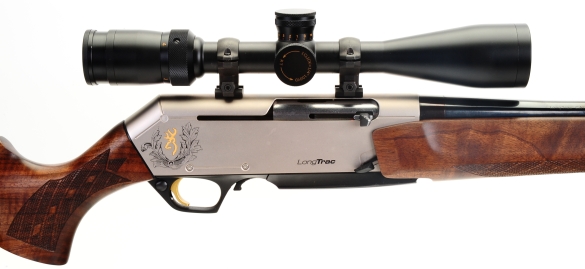
Emptied ejected hot. However, the receiver, and the barrel area closest to the receiver that ran warm for the first five or six rounds, seemed to get much cooler for subsequent shots. I would attribute this to the combination of the hammer forged steel barrel rapid heat dissipation characteristics of the aircraft aluminum receiver.
The trigger on the LongTrac is exceptional. Short, crisp and light with a no creep break and under four pounds. It is the best trigger I’ve ever pulled on an autoloader and I believe, overall, it contributed a great deal to my ability to shoot the rifle accurately. Virtually ever other commercial autoloader trigger I’ve pulled has felt like squeezing a stale gummy bear… found in the bottom of a hunting jacket pocket. Right, like you’ve never been out hunting, cold and hungry and a long ways from the truck.
Truthfully, the Browning BAR is too refined to be George Thorogood “Bad to the Bone” and you would look out of place at the range shooting it while wearing a ghillie suit. However, the LongTrac would leave little doubt in any shooter’s mind that it, and the 300 Winchester Magnum, make a powerful combination that is suitable for hunting North America’s largest game. By the same token, its appearance is not so slick it would make you feel like a … fancy lad. The Browning LongTrac is an impressive hunting rifle and a great to shooter.
For further information, you may want to stop by www.Browning.Com.
Browning’s BAR LongTrac Part 1
Browning’s BAR LongTrac Part 2


Email Notification